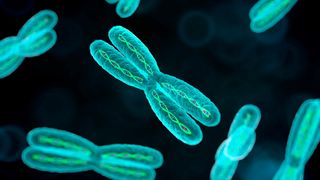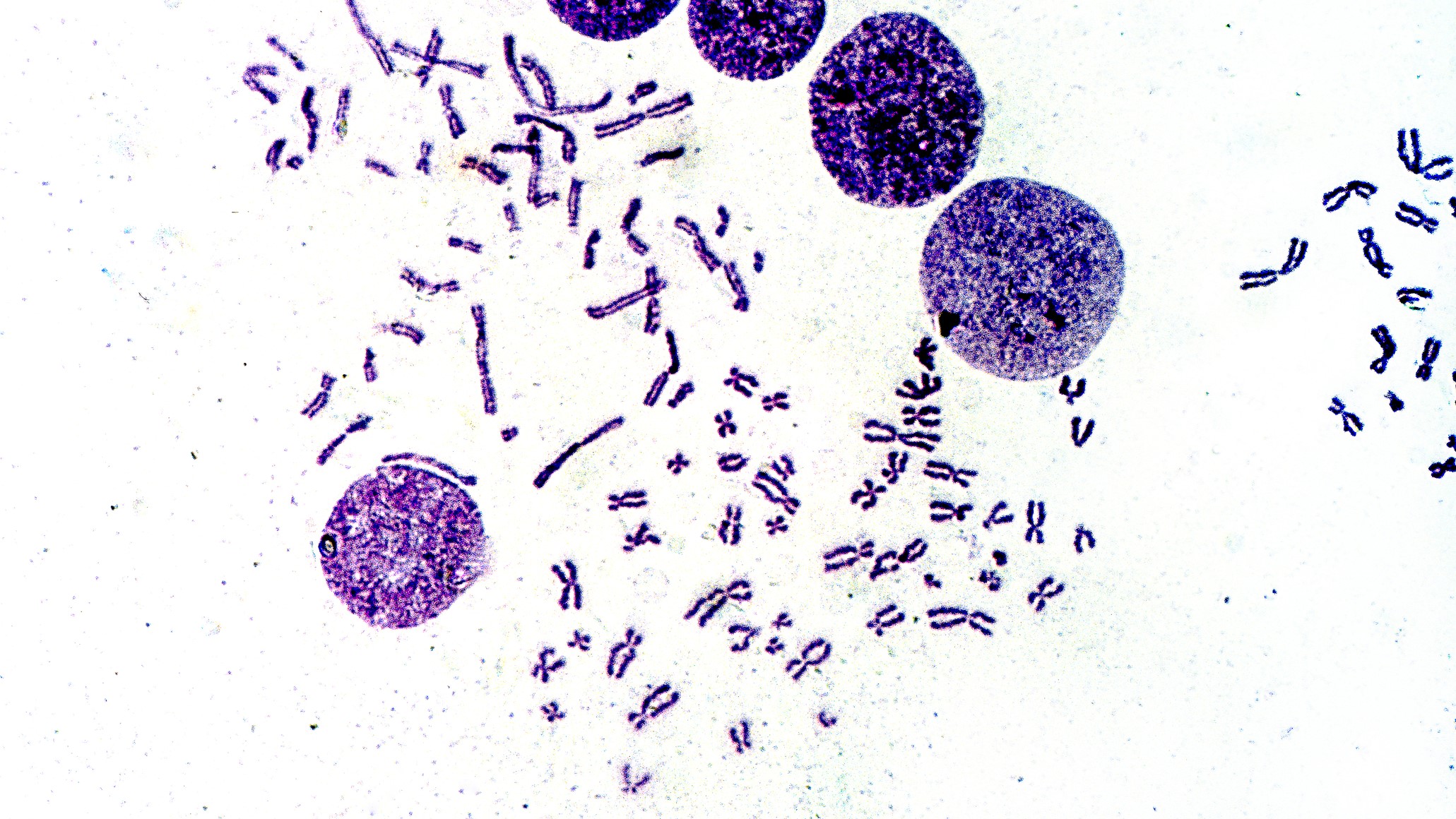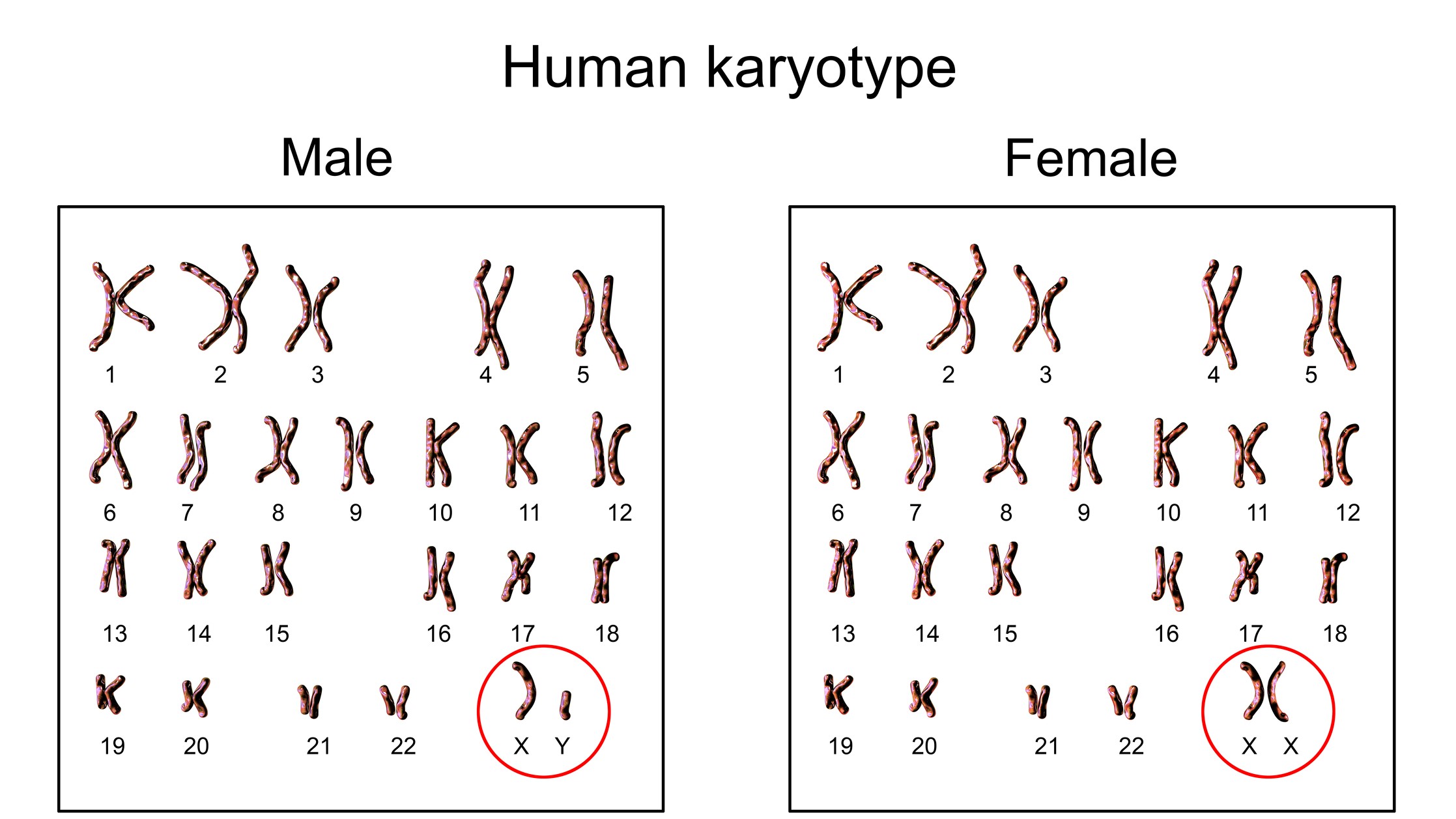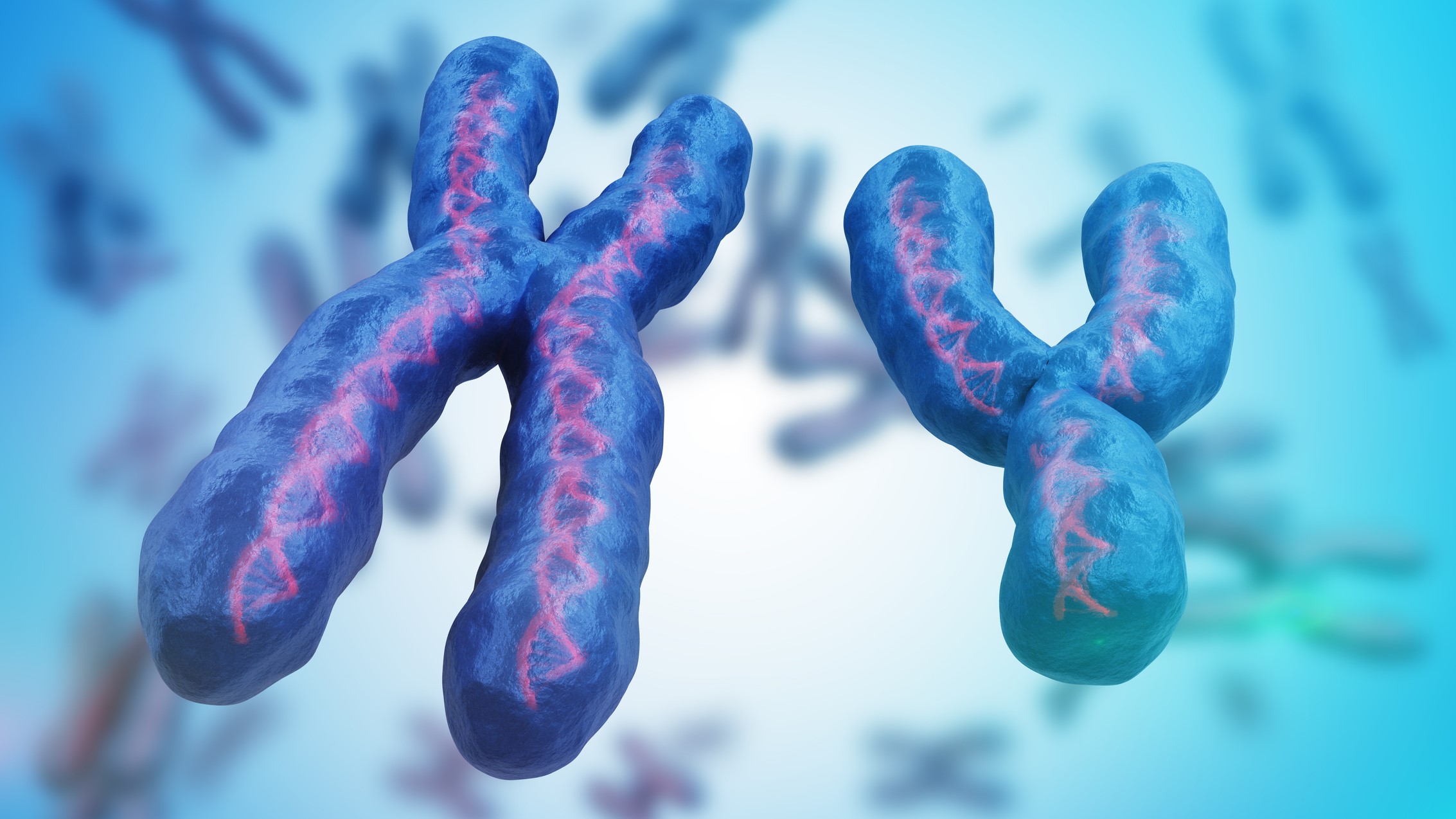A Human Baby Has Two X Chromosomes Its Sex Is
Chromosomes: Facts about our genetic storerooms

Chromosomes are defined as thread-similar structures of deoxyribonucleic acrid Deoxyribonucleic acid that conduct hereditary information for everything from peak to eye color. They are found in the nucleus of a cell and help ensure Deoxyribonucleic acid is replicated and divided evenly during prison cell division, according to genomics website Healio.com. Chromosomes consist of a poly peptide and a single molecule of Deoxyribonucleic acid. Chromosomes make us who nosotros are.
Your Dna blueprint (genome) doesn't exist as one continuous scroll tightly rolled up in the nucleus of each cell. Instead, your Dna is divided into 46 'capacity' chosen chromosomes — 23 from each parent. These 23 chromosomes from each parent pair up and form the 23 chromosome pairs in each cell.
Chromosomes are packaging masters, without them DNA would simply not fit inside cells. Chromosomes go on Dna coiled around spool-like proteins known as histones, co-ordinate to the National Human Genome Research Establish. If you unraveled all the Dna from a single man cell and placed it cease-to-terminate, it would stretch 6 feet (1.8 meters)!
Not all chromosomes are created equal. Some contain a lot of genetic cloth whilst others behave comparably trivial. Chromosome one for instance is the biggest and contains eight percent of your total Dna according to Medline Plus. An private'south collection of chromosomes is called a karyotype. The term chromosome comes from the Greek words for color (blush) and trunk (soma) due to their ability to be strongly stained by dyes used in enquiry according to the National Human Genome Research Institute.

Number of chromosomes
The number of chromosomes an organism possesses varies considerably just has little to practise with the complexity of the organism or the quantity of Dna information technology possesses. Most humans take 46 chromosomes whilst a white potato has 48! Co-ordinate to the National Man Genome Inquiry Institute, most bacteria have just one or two circular chromosomes, a fruit fly has viii chromosomes, a rice plant 24, and a dog 78.
But some organisms accept chromosome counts in the thousands! The globe record holder for the highest chromosome number recorded is the adder'due south tongue fern Ophioglossum reticulatum, with an estimated one,440 chromosomes (or 720 pairs!), according to the Guinness World Records.
In humans, if the number of chromosomes changes, information technology can lead to changes in growth and development, according to Medline Plus. When an organism is missing chromosomes or has actress chromosomes it is known as aneuploidy. Trisomy, refers to the presence of an extra chromosome in cells, an example of a status acquired by trisomy is Downward'south Syndrome. People with Down'southward Syndrome have three copies of chromosome 21, instead of 2 copies.
The only human cells that do not contain a pair of chromosomes are reproductive cells (gametes). Egg and sperm cells carry simply one copy of each chromosome then that when they unite they become a unmarried cell containing a pair of chromosomes.

X and Y chromosomes
Homo sex chromosomes are referred to as X and Y, and their combination determines a person's sex. Typically, human females have two X chromosomes while males possess an XY pairing. This XY sexual practice-determination system is found in almost mammals every bit well as some reptiles and plants.
Whether a person has 20 or XY chromosomes is determined when a sperm fertilizes an egg. Unlike the trunk's other cells, the cells in the egg and sperm — called gametes or sexual activity cells — possess just 1 chromosome, known as haploid. Gametes are produced by meiosis cell division, which results in the divided cells having half the number of chromosomes as the parent, or progenitor, cells. In the example of humans, this ways that parent cells have two chromosomes, known as diploid and gametes have ane.
All of the gametes in the female parent's eggs possess X chromosomes. The begetter's sperm contains virtually half 10 and half Y chromosomes. Sperm is the variable factor in determining the sex of the infant. If the sperm carries an 10 chromosome, it volition combine with the egg's Ten chromosome to form a female zygote. If the sperm carries a Y chromosome, information technology will result in a male.
During fertilization, gametes from the sperm combine with gametes from the egg to form a zygote. The zygote contains two sets of 23 chromosomes, for the required 46.
In that location are however some variations in the number of sex chromosomes. Recent research has found that a person tin can have a diverseness of different combinations of sex activity chromosomes and genes, particularly those who place as LGBT. For example, a certain X chromosome called Xq28 and a gene on chromosome 8 seem to be found in higher prevalence in men who are gay, according to a 2014 study in the journal Psychological Medicine.
It is important to remember that sex and gender have two carve up definitions and many cultures include more than labels than simply "male person" and "female" to identify others.
The structure of Ten and Y chromosomes
While the chromosomes for other parts of the body are the same size and shape — forming an identical pairing — the X and Y chromosomes take different structures.
The X chromosome is significantly longer than the Y chromosome and contains hundreds more genes. Considering the additional genes in the X chromosome take no counterpart in the Y chromosome, the 10 genes are dominant. This means that almost any gene on the 10, fifty-fifty if it is recessive in the female, volition be expressed in males. These are referred to as Ten-linked genes. Genes found just on the Y chromosome are referred to as Y-linked genes, and expressed only in males. Genes on either sex activity chromosome tin can be called sex activity-linked genes.
At that place are approximately 1,098 10-linked genes, though most of them are not for female person anatomical characteristics. Many are linked to disorders such as hemophilia, Duchenne muscular dystrophy, fragile-X syndrome and several others. They are responsible for red-green color blindness, considered the most common genetic disorder and found most often in males. The non-sexual activity feature X-linked genes are also responsible for male person pattern alopecia.
According to the National Human Genome Research Institute, the Y chromosome is near i-third the size of the X chromosome. The Ten chromosome has about 900 genes while the Y chromosome has about 55. The Y chromosome contains a 'male-determining gene' chosen the SRY gene. This factor is what triggers testes to form in the embryo, if there is a mutation in this cistron the embryo volition develop female genitalia despite having XY chromosomes.
Sex activity chromosome abnormalities

Abnormalities in the sex chromosome combination tin event in a diverseness of gender-specific weather that are rarely lethal. These abnormalities tin can be caused by full or partial chromosome deletions or duplicated sexual practice chromosomes, according to MSD Manual.
Turner syndrome occurs when females are missing or partially missing an X chromosome, according to the Mayo Dispensary. Turner Syndrome can cause a variety of medical and developmental problems including brusk stature, failure in the development of ovaries and centre defects.
Trisomy X syndrome — besides known as Triple X syndrome — is caused by 3 X chromosomes instead of two and affects approximately i in 1000 females according to the Mayo Clinic. Most people who have Trisomy X do not experience any symptoms or have mild symptoms. Occasionally, more than significant symptoms may occur which may delay the evolution of voice communication and linguistic communication skills, behavioral problems, seizures and kidney issues.
According to Medicine Plus, ane of the most common sex activity chromosome disorders is Klinefelter syndrome which affects approximately ane in 650 males and is caused by an extra X chromosome. In some cases, the symptoms can be so mild that many go undiagnosed until they reach puberty, and some researchers believe up to 75% of affected males may never know they take the status. Symptoms of Klinefelter syndrome include pocket-sized testes producing lower amounts of testosterone which can lead to delayed puberty, chest development, infertility and decreased muscle mass.
Boosted resources
To observe out more about chromosomes check out this material from Your Genome. Learn more nearly gender identity with Planned Parenthood. The Intersex Guild of North America has an insightful article on whether having a Y chromosome makes someone a human being. Discover more than about modes of inheritance and genetic nuts in animals with this article from VCA animal hospitals.
Bibliography
- Y Chromosome Infographic, The National Human Genome Research Establish.
- What are trisomies and monosomies? Boston'southward Children Hospital.
- Klinefelter syndrome, Medline Plus.
- Triple Ten syndrome, Mayo Clinic.
- Down's Syndrome Association
- Gardner, RJ MKinlay, Grant R. Sutherland, and Lisa Thousand. Shaffer. Chromosome abnormalities and genetic counseling. No. 61. OUP USA, 2011.
- Schmidt, Carla, Patrick Schindele, and Holger Puchta. "From gene editing to genome engineering: restructuring plant chromosomes via CRISPR/Cas." aBIOTECH 1.1 (2020): 21-31.
- Sharma, Arun Kumar, and Archana Sharma. Plant chromosomes: Analysis, manipulation and technology. CRC Press, 2019.
- Hedrick, Philip W. "Virgin birth, genetic variation and inbreeding." Biological science Letters 3.six (2007): 715.
Source: https://www.livescience.com/27248-chromosomes.html
Belum ada Komentar untuk "A Human Baby Has Two X Chromosomes Its Sex Is"
Posting Komentar